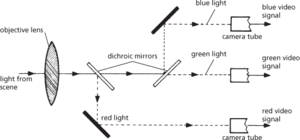The device used in a television system to convert the optical images from a lens into electrical signals. The optical image formed by the lens system of the camera falls on to a photosensitive target. This is scanned, usually by a low-velocity electron beam and the resulting output is modulated with video information obtained from the target area. The output signal can be considered as an essentially constant d.c. signal with a superimposed a.c. signal. The amplitude variations of the latter correspond to the brightness, i.e. the luminance, of the target. The d.c. component is the value of the video signal that corresponds to the average luminance of the picture with respect to a fixed reference level.
The camera consists of three major parts housed in one container: optical lens system, camera tube, and preamplifier. The resulting output is further amplified and transmitted in the broadcasting network. Some cameras are self-contained, with the amplifier and transmitter in the same container. These cameras are usually employed in a closed-circuit system, or for special applications, such as an outside broadcast. Several types of camera tube have been developed; the major differences between the various types of tubes are in the composition of the photosensitive material used and the means of extracting the electrical information produced.
The camera used in colour television consists of three camera tubes each of which receives information that has been selectively filtered to provide it with light from a different portion of the visible spectrum. Light from the optical lens system is directed at an arrangement of dichroic mirrors each of which reflects one colour band and allows other frequencies to pass through. The original multicoloured signal is split into red, green, and blue components, and the video output from the three camera tubes represents the red, green, and blue components of the image (see diagram). The scanning systems in the three tubes are driven simultaneously by a master oscillator to ensure that the output of each tube corresponds to the same image point. The three outputs are then combined to provide brightness (luminance) and colour (chrominance) information (see also colour picture tube).

Colour-television camera